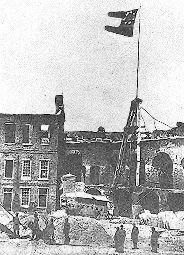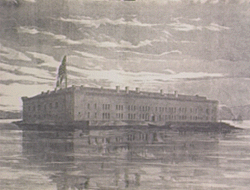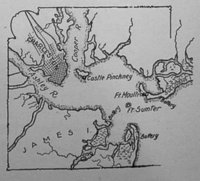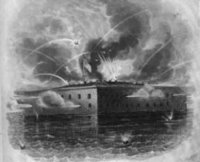Fort Sumter
|
|

Fort Sumter, located in Charleston, South Carolina, harbor, was named after General Thomas Sumter. However, the fort is best known as the site where the shots initiating the American Civil War were fired, at the Battle of Fort Sumter.
Fort Sumter was built after the War of 1812 as one of a series of fortifications on the southern U.S. coast. Construction began in 1829, using some slave labor, and the structure was unfinished in 1860, when the drama began. Seventy thousand tons of granite were imported from New England to build up a sand bar in the entrance to Charleston harbor, which the site dominates. The fort was a five-sided (although not a perfect pentagon) brick structure, 170 to 190 feet long, with walls five feet thick, standing 50 feet over the low tide mark. It was designed to house 650 men and 135 guns in three tiers of gun emplacements, although it was never filled near capacity.
| Contents |
Start of the Civil War (1861)
Main article: Battle of Fort Sumter
On December 26, 1860, six days after South Carolina seceded, U.S. Army Major Robert Anderson abandoned the indefensible Fort Moultrie and secretly relocated his two companies (85 men) of the 1st U.S. Artillery to Fort Sumter. Over the next few months, repeated calls for Union surrender from Brigadier General P.G.T. Beauregard were ignored, and Union attempts to resupply and reinforce the garrison were rebuffed. On April 12, 1861, at 4:30 AM, Confederate batteries opened fire, which lasted for 36 hours, on the fort. The garrison returned fire, but it was ineffective. On April 13, the fort surrendered and was evacuated. Accounts, such as in the famous diary of Mary Chesnut, describe Charleston residents along what is now known as The Battery, sitting on balconies and drinking salutes to the start of the hostilities.
A special military decoration, known as the Gillmore Medal, was later issued to all Union service members who had performed duty in Fort Sumter during the opening battle of the American Civil War.
1863–1865
With Fort Sumter in Confederate hands, the port of Charleston was a hole in the Federal naval blockade of the Atlantic coast. For the U.S. Navy to close the port, Fort Sumter would need to be retaken, and Rear Admiral Samuel F. Du Pont was ordered to take it.
On the afternoon of April 7, 1863, nine ironclads exchanged fire with Confederate batteries in the fort and around the harbor. The fort was barely damaged, but five of the ships were disabled. One, the USS Keokuk, sank the next morning. After this failure, federal strategy changed. Du Pont was replaced by Rear Adm. John A. Dahlgren, who planned to combine land and sea operations to seize nearby Morris Island and from there to demolish the fort. Union troops under Brig. Gen. Quincy A. Gilmore place rifled cannon on Morris Island. The fort's garrison consisted of five companies of the 1st South Carolina Artillery under Col. Alfred Rhett. They and slave laborers worked night and day to fortify the walls of Fort Sumter with dirt mounds and hay bales.
Massive Federal bombardment began on August 17, with almost 1,000 shells being fired the first day alone. Within a week, the fort's brick walls were in ruins, but the garrison refused to surrender and continued to repair and strengthen the defenses. Confederate guns at Fort Moultrie and other strongholds in the harbor returned fire.
Another U.S. Navy assault on September 9 failed again, losing five ships and 124 men trying to take the fort. The bombardment continued intermittently until the end of December.
In the summer of 1864, Maj. Gen. John G. Foster replaced Gillmore as commander of land operations and attempted again to take the fort. Foster, a member of Anderson's 1861 garrison, believed that "with proper arrangements" the fort could be taken "at any time." Two months of bombardment, however, failed to dislodge the Confederate garrison and Foster abandoned the effort. Intermittent fire was maintained until Maj. Gen. William T. Sherman's troops advancing north from Savannah, Georgia, forced the evacuation of Fort Sumter on February 17, 1865.
It is estimated that seven million pounds of artillery were shot at Fort Sumter during the war, yet the Confederate losses were only 52 killed and 267 wounded.
After the war
When the Civil War ended, Fort Sumter was in ruins and the U.S. Army attempted to restore it as a useful military installation. The damaged walls were releveled to a lower height and partially rebuilt. The third tier of gun emplacements was now gone. Eleven of the original first-tier gun rooms were restored with 100-pounder Parrott rifles.
From 1876 to 1897, Fort Sumter was used only as an unmanned lighthouse station. The start of the Spanish-American War prompted renewed interest in its military use and reconstruction commenced on the facilities that had further eroded over time. A new massive concrete blockhouse-style installation was built in 1898 inside the original walls. Named "Battery Huger" in honor of Charleston's Benjamin Huger, it never saw combat.
During World War I, a small garrison manned the two twelve-inch rifles at Battery Huger. Until World War II, the fort was unused except as a tourist destination; two 90-mm antiaircraft guns were then installed. Fort Sumter became a U.S. National Monument in 1948.
Today, administered by the U.S. National Park Service, Fort Sumter is a popular tourist attraction, reached by a thirty-minute boat ride from Charleston.
External links
- National Park Service's Official Website for Fort Sumter (http://www.nps.gov/fosu/)
- Charleston website with Fort Sumter history (http://www.ego.net/us/sc/chs/tts/sumter.htm)
- Battle of Fort Sumter (http://www.sonofthesouth.net/leefoundation/battle-fort-sumter.htm)Historical Preservation Site



